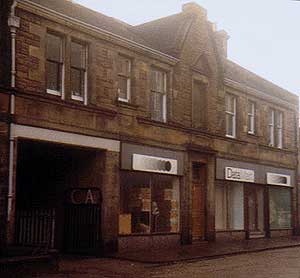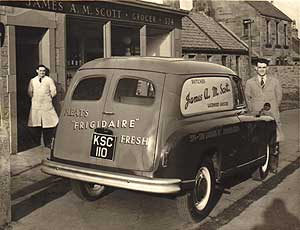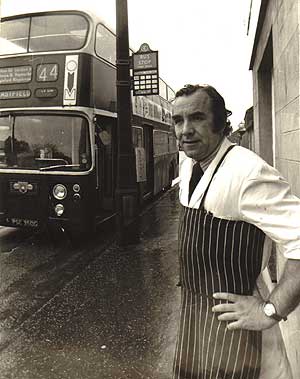I remember... the shops in the village (from the 1960s)
Douglas Stuart remembers the shops of Juniper Green over the last fifty years in extracts from an interview with David Geary on Friday 4th August 2006.
Veitch's shop, the florist and the garden centre were just outside the boundary of the village on the west. But there was an old man called Johnny Morgan who was an electrician and related to the Nisbets in the village. Although Johnny did not have a shop as such he had a storeroom and people in the village, when they got electricity just after the Second World War, used Johnny. He would do odd jobs. You would say that was the first shop, really part of a house, up at the West End of the village. Coming down the south side of the street the next shop you reached was the Co-operative store. The store at the far side had the grocer's shop, then the baker's shop, then the butcher's shop. That's where the lane is now; it used to be the butcher's shop. Up the stair was the millinery shop; that's where they had threads and needles and all the sewing materials. That part was demolished and rebuilt as a superstore.
Across the road was Ferguson's the painter where the beauty shop is today. I'm talking about the thirties and the forties. The shop was first run by his father William Ferguson before the Second World War. Then Jim Ferguson the son took over. Jim and his sister lived there.
The next shop down would be back on the south side and it was mine, built in 1894 I think. It was built for a lady called Jessie Maxwell, my Great Aunt. She opened the shop but it wasn't opened as a newsagent, it was what was called "a Johnny all things shop". It was a place you could buy your kettles, your pots and pans, and the buckets would stand outside. You might class it an ironmonger's shop today. Jessie married a man called John Stuart and he was quite an industrious man and originally there was a gap between the main building and the store and he built across the gap. It would be about 1903 when he added that part. The shop continued as an ironmonger's shop until about 1918. It was taken over by Bob Stuart, John's son, and he had a billiard table in the back of the shop. The young men of the day would come up and play a game in the back of the shop. And Bob had a penny vantage machine in there. A penny vantage was a machine that gave you a drink of different flavours. It was soda water but with different flavours. They would drink these as they played and I often wondered if they had something stronger. The shop changed from pots and pans to sweeties, confectionery, biscuits and one or two more food lines into the shop. This thrived because he stayed open and if you forgot to buy something at the store you could pop into Bob's. It built up from that and became a newsagent's shop around 1954 after Bob retired. He passed it on to a man who travelled for Brooke Bond, a man by the name of John Gilchrist. He was a character, a very nice man, and he had the shop until 1960/1 when he died rather suddenly. At that time I was a police officer and you weren't allowed to have a shop and stay in the service so I had to retire from the Force to take over the shop. We delivered papers from Dolphin Road in Currie right down to Kingsknowe, a very big area to cover. There were no other shops in the area that would handle papers at that time. It was quite comical on a Sunday since if your surname was A - M you went to one side of the shop for your paper but N - Z you went to the other side of the shop.
The dentist surgery used to be a house with a Mrs Horsburgh living there. A very nice lady, and kind to me. It was just a but and ben. The cottage next to that had a family related to Anderson the blacksmith, called Woods. The Horsburghs were an industrious family and he was a builder. They built quite a few things around here in the village. Cyril Chong Kwan bought it for his dentistry service. His business boomed but one up Lanark Road West did not.
Back across Lanark Road used to be the blacksmith's shop. His name was Mr Anderson, the village blacksmith. The corner building used to be in two parts and up the stair lived one of the village's characters, old John Tweedie, and I think he lived until he was over 100 years old. He was known as Uncle John to everyone in the village but he is not the one who wrote the history, that was one of his junior relations. He was a character and a half; if you wanted to know anything about what was going on in the village then you would go to Uncle John.
Then next door, there is the small cottage, which used to belong to Mrs Bryce. But later Jock Westwater, the printer, took it over. Prior to Jock was Dave Cohen, who was a potter. And he did some wonderful pottery. The potter was around in the 1970s and 1980s but went down to North Berwick to set up a bigger pottery.
Next to that is the Kinleith Arms. Kinleith is my pub. I also would go down to the old bowling club when it was where the by-pass is today. I can remember in the 1970s when the SNP were coming up - Ernie Calder, one of the relations of the publican at the Kinleith, and there was a painter and decorator called Jimmy Henderson. Ernie was a great SNP man and Jimmy was a lovely fellow. Mr and Mrs Scott used to run the pub and they were brilliant people. When the pub changed from being a family run business to a chain they tried to clean up the painting on the wall and they mucked it up. You could tell the village characters in the painting before they cleaned it up but not after it had been done. Davie Walker, Bill Gullen, Kenslie and old Tweedie were in it, I think.
Back on this side there is the small shop that is the electrician's [ed. now owned by George Byers]. But, going back before my time, it was owned by a lady who sold sweets. There were one or two other shopkeepers between the sweetie shop and when the electrician took it over.
Then there was the shop under Della Purves' house, owned by two sisters. It was a wine and spirit shop and a highly exclusive grocer's shop. Some would go in there for their discreet bottle of sherry and come out with a smile on their faces. That would be in the 1950s and 1960s. The sisters were called Miss Martin.
Back across the road there was the petrol station owned by Jim Bryce, not John Bryce. Jim Bryce had a garage there, he had a couple of lorries on the go and he had great big Hillman cars he used to chauffeur people around. He had several cars and was related in some way to John Bryce who had a contractor business down where Juniper Place is today. Jim had his business either side of the War. Jim had his petrol station and where the bowling club is today was his yard. At that time he had a 1500-gallon tank of diesel. You could buy it for 2p per gallon. Tom Bryce was Jim's brother and he too ran a lorry using diesel and they had a couple of coal lorries as well. There were two occasions when the kids got in and turned the tap on and the whole place got flooded with diesel.
Next shop down is of course Scott's. I'm talking about the last fifty years or so, as I'm really an incomer to the village even now. I've always known it as Scott's and in the old cottage they used to keep hens for the eggs. The shop belonged to the Cattanachs before the Scotts.
Back across the road and to the alley beside Miss Martin's shop you have the key shop and then the hairdressers. The key shop has been all sorts of things over the years. It's been a millinery shop, a small café, a booze shop and a bookie.
The fishmonger is quite a new shop. It was built by Alfie Keddie. He was quite a character in the village. He was a builder, but he turned his hand to most things: if you needed your rones or roof sorted then Alfie was your man. Juniper Gardens was built by Alfie Keddie. Alfie would put granite stone down in his foundations and you would not get any damp in his houses.
Past the Chinese carry-out you had the Scottish Building Society and a house agent. But before that it had been Allison's bakery. He was a damn good baker. He had been in the War so I think he would take over the business around 1946/7 or so. Betty Allison still lives across from here, she used to serve in the shop. He supplied me with bread rolls. A village shopkeeper would not go outside the village if he could help it.
There was a shop between Scott's and the present day bookie's and it was a general store owned by Bert Porteous. He was a great chap, another fine village man. He started up in his house and he had a small paraffin tank at the back and he would sell paraffin. He would sell bric-a-brac. You could get anything in Bert's shop. He built an extension over the front garden but it is now back as a private house.
The bookie's and what was the wine shop [ed. reopened as a wine shop October 2006] are new, there was nothing there before. The bottom house before you come to the bookie's, that used to be the bank. I banked there in the 1960s and it must have been around 1965 when they built the new bank.
After the old bank house came the chemist and then the Railway Inn. The chemist then moved across the road to where the chip shop and restaurant are now, then again down to its present location. The Railway had its own clientele for many years and it was only under Mr Love that it opened up a bit. He brought in one or two rules, which did not always go down well with some of his regulars. He had a style and a way of serving his clients that pleased them.
Back on the other side is the old manse house. Then, where there is now a block of flats there used to be a garage. The chippy and the restaurant are relatively new. They would be built in the 1980s.
There used to be a bakery shop and then a flower and vegetable shop. It was a good but small vegetable shop; you could just nip into these places. Then, the toilets before the post office. I think there have been four owners of the post office while I've been here. Old Mr Scott had the post office many years ago.
Across from there was Peter Smith's the grocer's shop. Margaret was Peter's wife but I think Mr Scott had the place before Peter. Peter worked his heart out; he was a great worker, great fellow, another one of what you would call a village worthy.
Next to him was a fruit shop where the chemist is today. It became a sweetie shop in the hands of another village character [ed. Wilma Baxter].
J. Howitt the builder's had a joinery shop on Baberton Avenue. There might have been some workshops up there but I don't recall any other shops up there.
Belmont Garage on Belmont Road came along in the 1980s. That was vacant ground. There was always a lot of such ground around the village even up to the middle 1980s.
The only other place I know is the Pentland Arms, or what they call Tanners now. Davie Simpson had it when I first knew the place. It changed its name probably in the early 1990s. It was called Bennett's Bar but that is going back beyond Davie Simpson's time. There are a tremendous amount of pubs for a small population and they all boomed in their day.
The village had four or five families originally: Ellis, McKenzie, Tweedie and Scott and maybe the Calders. It was a close knit village. I was fortunate to be called Stuart. I was partially accepted. But, if you came with a name foreign to the village it was frowned upon. I was born and brought up in Gilmerton. My wife was too and it was the same, a small village. You were not part of Edinburgh. This was the country; people would come up to the park for a picnic. As a boy I would cycle over the hill to the Water of Leith and guddle for trout.
The number eight buses used to come up here. Then we had 44, 45 and 46 and they would turn by going along Belmont Road and up Juniper Avenue. The terminus used to be at the top of the road here. On a Saturday you would see several buses parked waiting to take Hearts supporters down to the match.
The horse and cart sales were going out just after the War. Mrs England's van would come around and John MacKay still at the bowling club, he would drive it. And they would bring fruit and veg around into the 1960s and 1970s and possibly into the 1980s too. John Fisher, who is the brother of Charlie Fisher who had the Post Office, had a fruit shop down in Happy Valley and he had a van for years too.
We didn't have a decent fish and chip shop in the village until the 1980s. You had to go down to Slateford to get a chippy. There was no chip van in my time. When they did open one up it was such a success, the village was crying out for a chippy.




